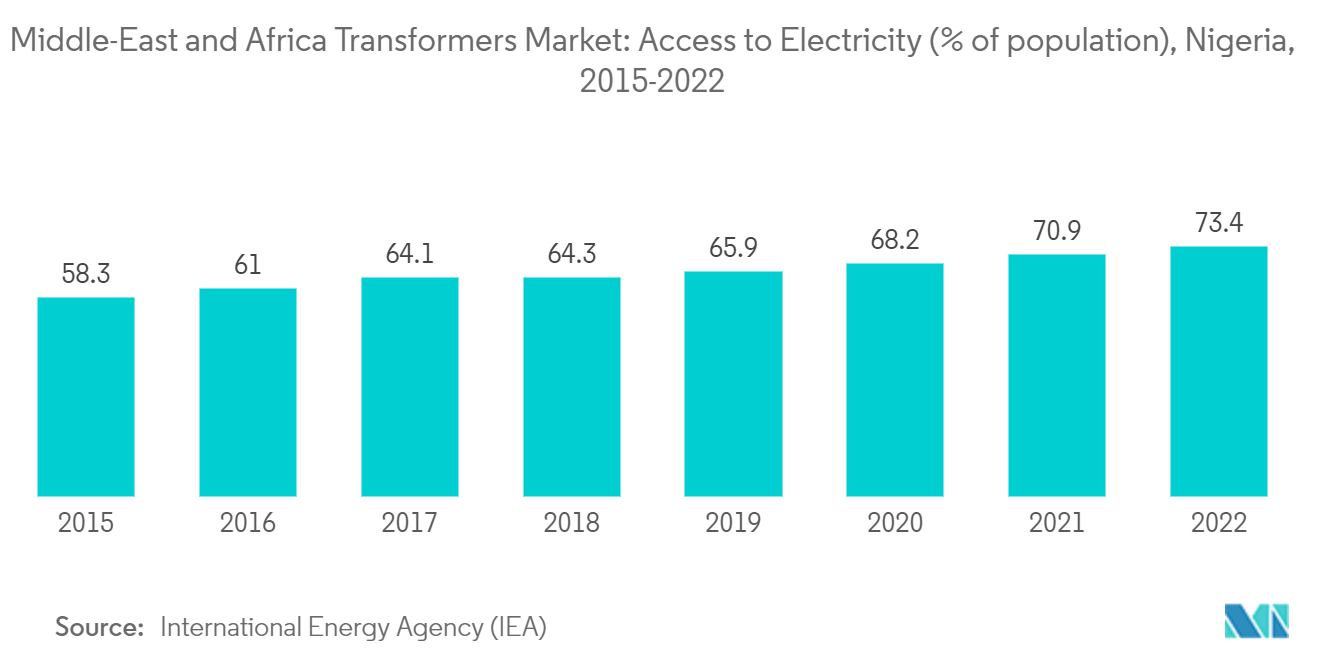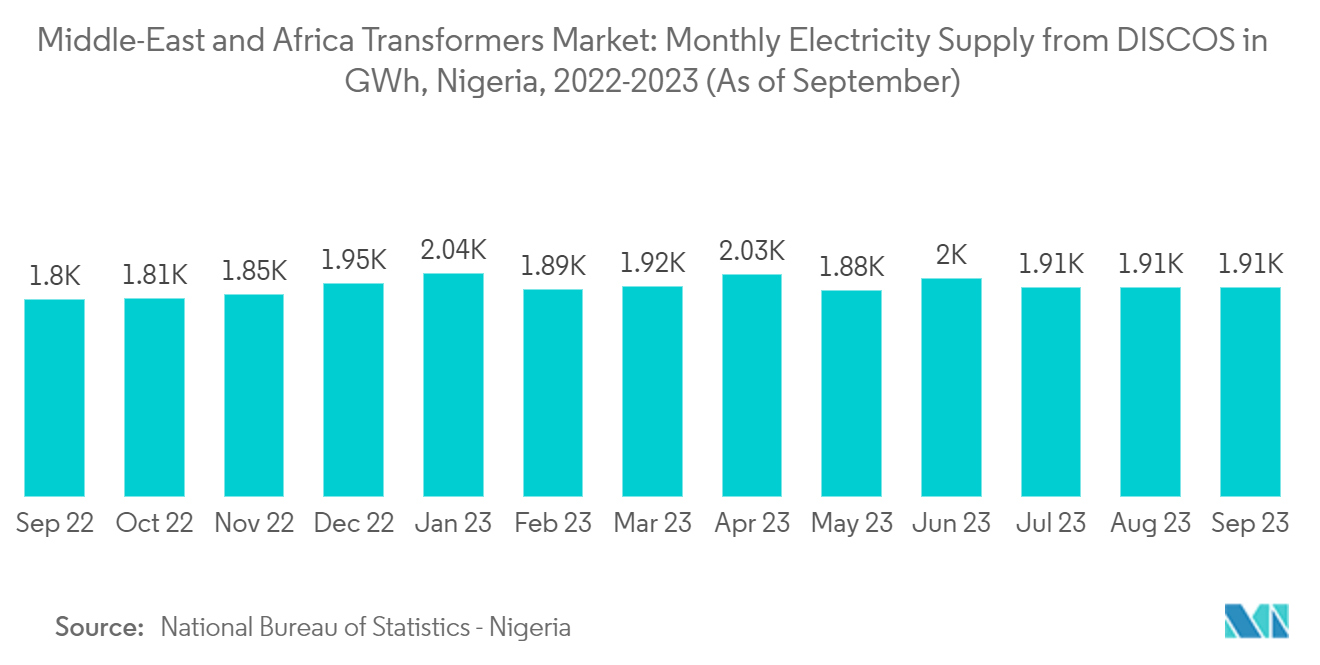Market Trends of Middle East And Africa Transformer Industry
Air-Cooled Segment to Dominate the Market
- A dry-type transformer or air-cooled transformer is a type of transformer that uses air as a coolant. It includes no moving parts and is a static device that uses environment-friendly temperature insulation systems. The dry-type transformer is more environment-friendly than the oil-filled type transformer. It is less flammable and poses a lesser fire risk. It is employed in various applications, including high-rise buildings, airports, stadiums, hotels, shopping malls, chemical and refinery plants, substations for interior cities, rural areas, and residential complexes.
- The ongoing industrialization in the Middle East and Africa is a crucial driver for the air-cooled transformers market. As industries expand and diversify, the demand for reliable and robust electrical systems increases. Air-cooled transformers, due to their ability to efficiently handle varying loads and environmental conditions, are well-suited to meet the challenges posed by industrial applications. This industrial growth, coupled with the development of smart grids and renewable energy projects, is expected to boost the market for air-cooled transformers in the Middle East and Africa further.
- For instance, in August 2023, the Saudi Electricity Company (SEC) made a significant move in bolstering the energy infrastructure of the NEOM mega-city by granting a contract worth USD 198.3 million to Al Gihaz Contracting Company Saudi Arabia. This project focuses on constructing the NEOM Mountain substation. It will be a cutting-edge indoor 380/132kV Gas Insulated Substation (GIS) located within the futuristic NEOM city in Saudi Arabia.
- Similarly, in September 2023, Federal Transformers and Switchgears LLC (FTS) Oman, a division within the Smart Electrification and Automation Sector (SEA) of the Zubair Corporation, announced the successful delivery of the initial shipment of 'Made in Oman' Packaged Substations (PSS) to KAHRAAMA, the Qatari Establishment for Electricity and Water, Qatar, in accordance with a two-year contract.
- The demand for dry-type transformers in the past years is driven by the increasing demand for electricity on account of urbanization and industrialization. It is also coupled with the low daily maintenance cost of dry-type transformers, especially in countries like Egypt, Libya, Nigeria, Kenya, and others.
- According to the International Energy Agency (IEA), in Nigeria, the Share of the population with access to electricity increased by 3.53% in 2022 relative to 2021, led by air-cooled transformers. In addition, air-cooled transformers require no maintenance and are a pollution-free solution. Hence, it includes a high demand in commercial and residential segments in the Middle East and Africa region. Although the air-cooled transformer is long-lasting with less chance of winding failure, once it fails, the whole set-up needs to be changed, which is a capital-intensive process.
- Overall, the demand for air-cooled transformers is expected to increase during the forecast period as the demand for power T&D infrastructure increases in the Middle East and Africa region. This is also coupled with the advantages of the air-cooled transformer, which can be used in commercial and residential places without many hazards and environmental damage.

Nigeria to Witness Significant Growth
- Nigeria is the largest country in Africa in terms of population and is also one of the largest consumers of energy globally. Due to a lack of electricity supply, the country experiences constant power outages. Most local inhabitants are forced to depend on alternative distributed generation solutions such as diesel-powered generators.
- Nigeria's transmission sector is regulated by the Transmission Company of Nigeria (TCN), a company Transmission Company of Nigeria (TCN). Its activities include electricity transmission, system operation, and electricity trading. TCN is responsible for evacuating electric power generated by the electricity generating companies (GenCos) and wheeling it to distribution companies (DisCos) through its transmission infrastructure.
- According to the National Bureau of Statistics in Nigeria, the total electricity supply from the DISCOS reached about 21,817 GWh in 2022, a decrease of over 6.6% from 2021. Further, in 2023, the total electricity supply for the three quarters stood at around 17,493 GWh (as of Q3). The Nigerian government attributed the leading cause of poor power supply in the country to the low supply of gas to generating companies (GenCos).
- TCN revealed that numerous projects, including the development of substations, lines, and other electrical systems, are ongoing in the country. For instance, in 2022, TCN received a delivery of 15 new transformers from the Apapa port in Lagos. The transformers include ten 60 MVA 132/33kV and five 150 MVA 330/132kV capacity transformers delivered to TCN Central Store in Ojo. It is from here they are expected to be delivered to various projects across the nation.
- On installation and connection to the grid, the ten 60 MVA 132/33kV and five 150 MVA 330/132kV capacity transformers will add 637 MW and 850 MW, respectively, to the transmission network. It will consequently raise the total capacity of the transmission system by 1487 MW while ensuring N-1 reliability criteria in the substations. All these highlight that the deployment of transformers in the electricity infrastructures is increasing in the country.
- The Government of Nigeria also aims to increase generation capacity by at least 1 GW annually till 2025. They will ensure it by the completion of under-construction power generation projects such as the 700 MW Zungeru Hydroelectric Power Project and the 215 MW Kaduna Gas Power Plant. As power generation grows, it is expected to drive the demand for new power transmission infrastructure, such as power transformers, during the forecast period.
- In November 2023, the TCN delivered a new 60MVA 132/33kV power transformer to its 132/33kV transmission substation in Ojo, Lagos. It is part of steps towards completing Phase 1 of the Nigeria-Siemens power project, with the aim of increasing the end-to-end operational capacity of the power supply from around 5 GW to 7 GW.
- Further, to boost the current wheeling capacity, the Transmission Company of Nigeria (TCN) announced in December 2023 that it had received seven additional power transformers to augment the electricity supply to Lagos. According to the statement by the general manager of the TCN's Public Affairs, the new transformers will substantially surge the entity's delivery capacity. Seven new power transformers with capacities ranging from 60MVA to 100MVA and their accessories were recently delivered to the Akangba 330/132kV transmission substation.
- Thus, initiatives to modernize and expand Nigeria’s electricity grid, coupled with investments in the form of financing agreements with international monetary institutions, are expected to significantly boost the demand for power transformers in Nigeria. The market is expected to grow at a significant pace during the forecast period.


